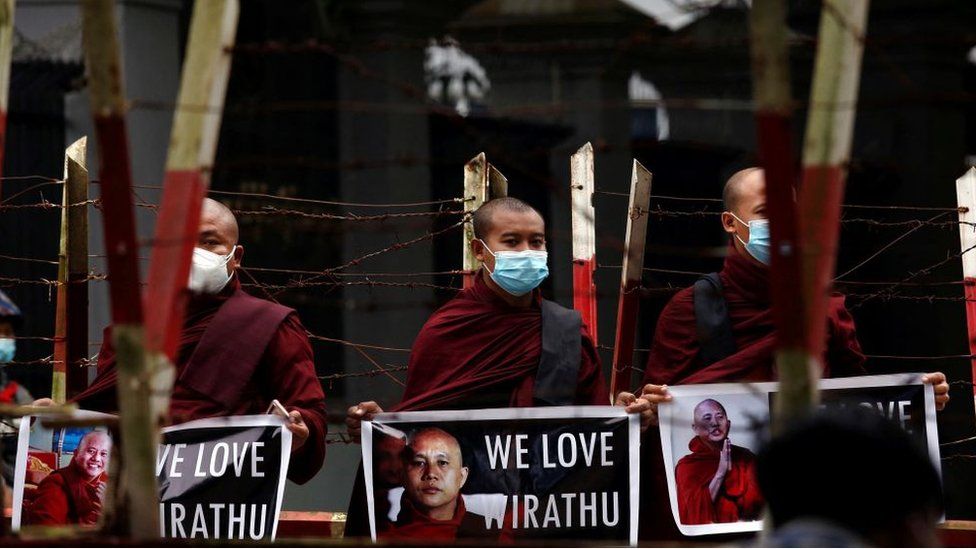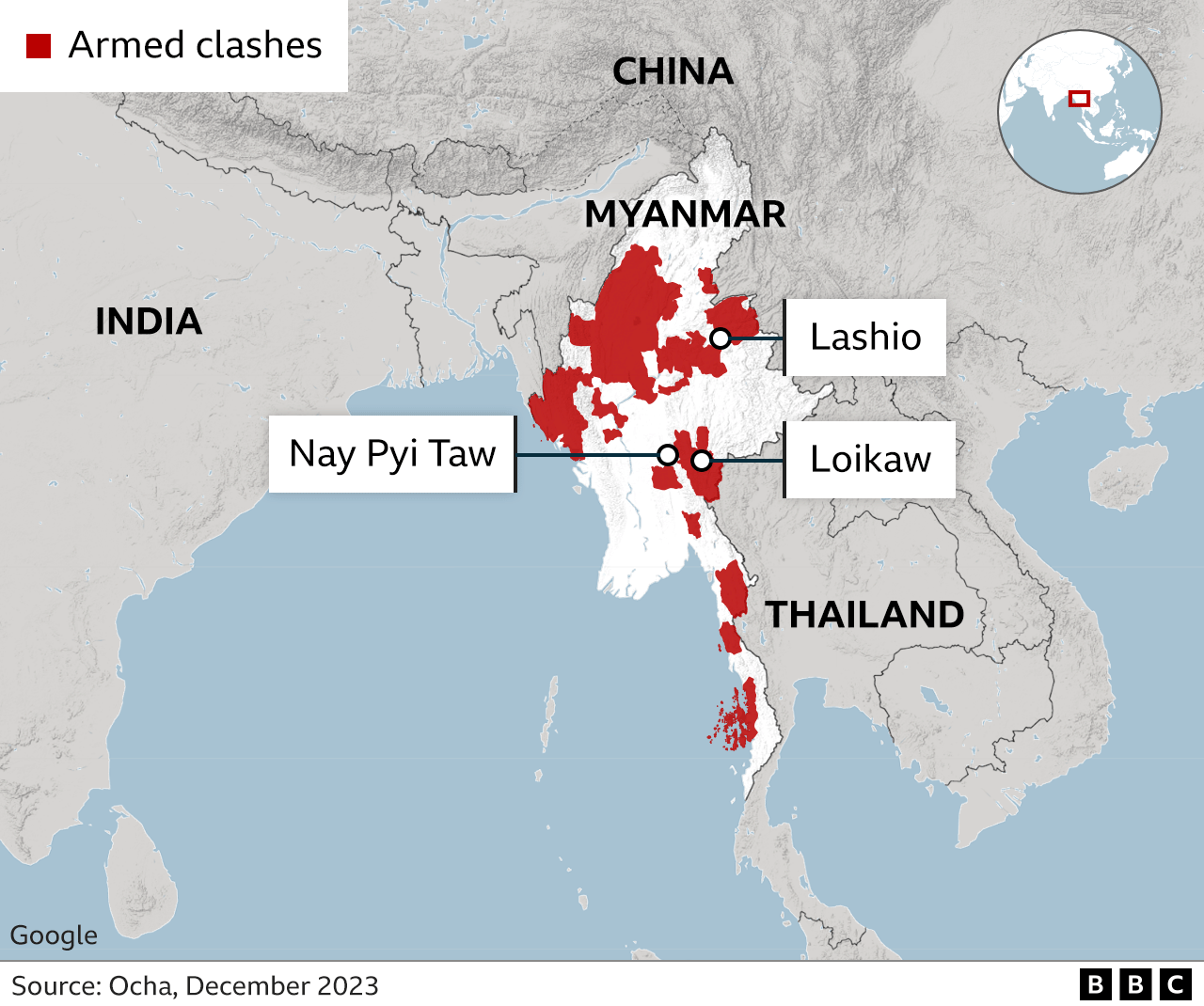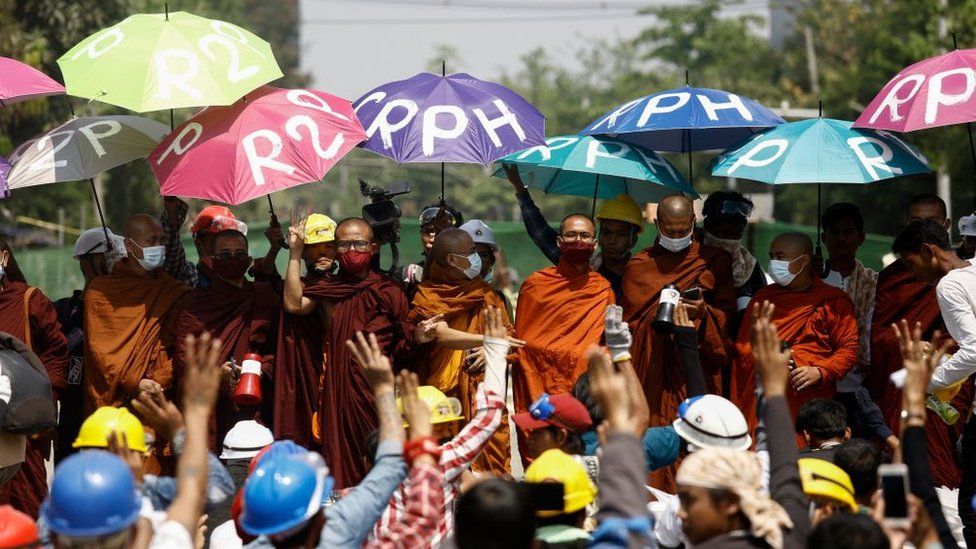Last Tuesday, a noisy crowd of several hundred people stood in the small main square of Pyin Oo Lwin, a popular Myanmar hill town, to hear a bespectacled monk make a startling suggestion.
Min Aung Hlaing, the country’s military ruler, should step aside, he said, and let his deputy General Soe Win take over.
The man who led the 2021 coup against the elected government of Aung San Suu Kyi, provoking a catastrophic civil war, has faced plenty of international censure, and is loathed by much of Myanmar’s population.
This though was criticism from an unusual quarter. The monk, Pauk Ko Taw, is part of an ultra-nationalist fringe of the Buddhist clergy, which has until now been staunchly behind the military junta.
But a series of crushing defeats suffered by the army at the hands of ethnic insurgents in recent weeks has prompted Min Aung Hlaing’s one-time cheerleaders to reconsider.
Running out of friends
“Look at Soe Win’s face,” Pauk Ko Taw said to the crowd. “That’s the face of a real soldier. Min Aung Hlaing is not coping. He should move to a civilian role.”
It is not clear what kind of backing Pauk Ko Taw has in the armed forces. But his comments echo those made by other junta supporters, who are increasingly frustrated by the seeming inability of Myanmar’s military leaders to turn the tide against their opponents. Pauk Ko Taw declined to be interviewed by BBC Burmese.
That he chose to give his speech in Pyin Oo Lwin will have added weight to it. The one-time British colonial hill-station is now home to the prestigious Defence Services Academy, where the army’s top brass are trained. They could hardly miss the thinly-veiled warning: that they are running out of friends.
The nexus between the military and monkhood is nothing new.
Burmese monks have a long tradition of political, often anti-authority activism, from the anti-colonial movements of the 1930s to uprisings against military rule in 1988 and 2007. Many opposed the 2021 coup, some abandoning their robes to take up arms against the junta.
But some have worked with the generals, sharing with them a belief that both Buddhism and Burmese culture need defending from outside influences.
Following violent clashes between local Buddhists and Muslim Rohingyas in Rakhine State in 2012, one militant monk, Wirathu, helped set up a movement known as Ma Ba Tha, or the Association for Protection of Race and Religion.
It encouraged a boycott of Muslim-owned businesses, claiming that Burmese Buddhism was in danger of being wiped out by Muslims. But they make up just 8% of the Myanmar population. The movement was officially disbanded in 2017, but has continued to enjoy military support.
Wirathu, who had earlier been jailed for inciting racial conflict, was jailed once again in 2020. But less than a year later he was freed by the military – and Min Aung Hlaing showered him with honours and cash.
Min Aung Hlaing’s coup in February 2021 provoked a huge public backlash, with massive rallies demanding a return to democratic rule, which were brutally put down. The 67-year-old general has since sought to bolster his legitimacy by presenting himself as a champion of Buddhism.
State media puts out a continuous stream of reports showing the diminutive dictator lavishing gifts on temples, and as a pallbearer at the funerals of senior abbots.
He has also been seen laying the foundation stone of the world’s largest seated Buddha statue in the capital Nay Pyi Taw, funded by his military administration.
Myanmar’s top religious body, the governing Buddhist council or State Sangha, has said little publicly about the coup. Some of its members are believed to have quietly urged restraint on the generals. But one senior monk in the Sangha, Sitagu Sayadaw, has openly supported the military, and even travelled with Min Aung Hlaing on an arms-buying trip to Russia.
Other monks have gone even further. One of Wirathu’s followers, Wathawa, has been helping set up armed militia groups in his home state of Sagaing, to challenge the volunteer People’s Defence Forces, which have sprung up all over the state to fight the junta.
Photos posted on social media carry the jarring image of saffron-robed monks being shown how to fire rifles.

The militias – named Pyusawhti after a mythological Burmese king – have been accused of forcibly recruiting local men, and of multiple atrocities against civilians. But they have taken root only in the small number of communities where the military’s own party is traditionally strong. They also appear to have been ineffective in countering the now extensive and organised opposition to military rule.
One man contacted by the BBC in the area where Wathawa has been mobilising since early 2022 said he had only been able to recruit a maximum of 10-15 men in each village, and then only by threatening to burn down their homes.
He said many of the recruits had run away, and were being helped by other villagers to hide from Wathawa and his gun-toting monks.
An army on the retreat
Now the shambolic performance of the army in its recent battles with ethnic armed groups is sowing doubts in the minds of its supporters.
One prominent blogger recently called Min Aung Hlaing “incompetent”, saying that under him the country had experienced loss and shame of historic proportions, for which he should pay the price and step down.
He was referring to the huge swathes of territory in northern Shan State taken by insurgents from the Brotherhood Alliance, three ethnic armies which now control much of the border with China.
They launched their operation in October last year, culminating in the surrender of thousands of soldiers, and all their equipment. The bloody two-year stalemate, between the well-equipped armed forces and the hundreds of volunteer groups which had risen up and joined the ethnic insurgents to fight the junta, appeared to have been broken.
The army has continued to retreat in the first weeks of this year. On the other side of the country near the Bangladesh border, the Arakan Army, one of the three groups in the alliance, has taken over several military bases, giving it control of large areas of Chin and Rakhine States.

It has posted videos showing bedraggled troops in tatty uniforms being led away handcuffed with cable ties, and huge caches of captured weapons and ammunition.
Unable to secure the roads from ambush, the military is relying on its limited number of helicopters to re-supply surrounded bases, and on air strikes to defend them, causing extensive civilian casualties. Insurgents in Kachin State say they have shot down one helicopter and one combat jet this month.
Some of the capitulating soldiers have turned out to be mixed units with little combat experience. The fact that many were also living in these bases with their families suggests they were unprepared to fight.
Hundreds chose to flee over the border to India; thousands have surrendered without a fight. Six generals defeated in Shan State were pictured afterwards drinking toasts with their captors, and looking more relieved than humiliated. After being handed back to the army three of them were sentenced to death, and the other three given life sentences, presumably in the hope of deterring others from giving up.
Such reverses are unprecedented in the 75-year-long history of the Myanmar military’s campaigns against insurgents. Morale in the ranks has crashed. Recruitment in these circumstances is proving difficult.
Allies turned foes?
So should Myanmar’s coup leader be worried about these disaffected voices?
Pauk Ko Taw’s bold criticism from the stage last week appears to have struck a nerve. Afterwards he was detained by soldiers and questioned, but quickly released, suggesting he does have some powerful backing. While his rally was reported in state media, his comments about Min Aung Hlaing were not.
Gen Soe Win, the man Pauk Ko Taw was urging to take over command of the army, is reported to be unhappy about the poor performance of his troops.
But he has shown no signs yet that he is prepared to usurp his boss’s role. For the moment that seems unlikely to change.

Min Aung Hlaing has also proved adept at promoting and then sidelining potential rivals. Last September the general once thought to be his most likely successor, Moe Myint Tun, was suddenly arrested and later sentenced to life in prison for corruption.
For all of the dreams of the junta’s most ardent fans – of a knight in shining armour coming to restore morale in the ranks – there is no successor in view.
Even in the wake of shocking battlefield defeats, Min Aung Hlaing has continued to preside over official functions, more in the fashion of a monarch than a military commander.
Whether this is down to his confidence, or his isolation from reality, is not clear. But the military cannot afford more losses on the scale of the past three months.
The collapse of the junta’s forces in either Lashio, the main town in northern Shan State which is now surrounded; in Rakhine State in the west; or in Karenni State on the border with Thailand, where insurgents are close to taking the state capital Loikaw, might lead to a much wider breakdown in military morale – and the eventual implosion of the regime.



Leave a Reply